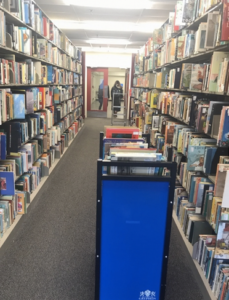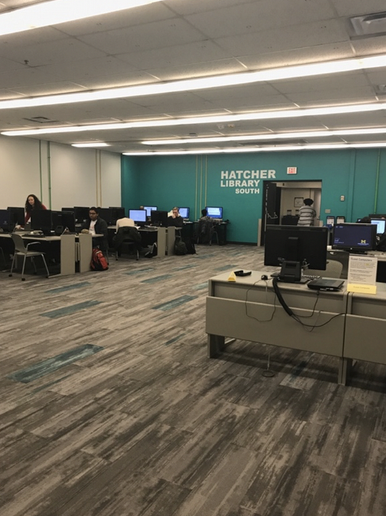Libraries in the Digital Age
How do students use libraries now that nearly all information is accessible online?
—By Joe Halpern

What image comes to mind when you think of a library? Is it a near silent room, filled with books and quiet readers? Or is it a more collaborative environment filled with both books and computers? Many people answer this question based on their college experience. Today’s modern academic libraries, including the libraries at the University of Michigan, fit the latter definition. While academic libraries are still filled with books, journals, and other traditional library holdings, they are also filled with laptops and computers providing access to millions of online resources. Due to the digitization of information, libraries are both more useful and confusing than ever before.
The trend of digitizing information is present at libraries everywhere. Nearly every student at Michigan can tell you that although there are plenty of hard-copy books available for use, the university’s library system is far from your old-fashioned, stereotypical library. The system keeps track of this information in their ‘Statistical Highlights’ section. In the 2016-17 school year, U-M libraries contained nearly 15 million volumes of physical books, while a staggering 22.5 million E-book sections and E-journal articles were downloaded. Half a million physical copies were in circulation, thus making online downloads the vast majority of the library’s transactions.
This trend is not merely limited to the libraries here at Michigan. The 2018 report from the American Library Association (ALA) on ‘The State of America’s Libraries’ shows the same trend occurring in all academic libraries. This report states that ‘the top five new services currently supported by academic libraries are web development, open access institutional repositories, learning systems, digital humanities, and digital media production.’ With all of the top five new services in academic libraries having something to do with digitization, it is clear that digital, online resources are both the present and future of academic libraries.
Although the change occurring in America’s academic libraries is fascinating to analyze, a question that often goes ignored is how are students expected to utilize the modern library? Do students even still go to the library? When doing research, do students check out books, use online library resources, and/or get help from library staff? Are there downsides to the digitization of information?
Going to the library
Given that so many of the library resources can be found online, do students even go to the library anymore? Yes, many students still go to the library, but its popularity can a deterrent for some. Yishai Ribon, a senior studying business here at Michigan, claims that he avoids the libraries because they are too busy; he prefers a calmer, more spacious workplace. He uses university desktops to aid him in his studying, and he says that “the computing areas are quite crowded” in the libraries. He says that he enjoys going to the Undergraduate library with friends when he has brief assignments to complete, but when he is swamped with work, he likes to go elsewhere.
Moustafa El-Kashlan, an economics student, also tries to avoid the libraries when studying, but for other reasons. “The chairs there are pretty uncomfortable and there is usually decently loud freshman there,” he quips. He adds that when he was an underclassman that he used to like studying in the libraries with friends, but now he likes to do work in “less formal study spots with more comfortable chairs.” Despite the uncomfortable chairs, both of the student interviewees and I agreed that the libraries are well-attended and are still some of the most popular study spots on campus. Even in an English class discussion, multiple people said the library is a popular hang-out spot for students.
Using library resources: print or online?
Even with the digitization of information, students still attend the libraries. But how do students utilize the library resources when they are there? Are students using library staff to aid them with their research?
El-Kashlan says that he has never checked out a physical book from the libraries at Michigan, while Ribon says that he has checked out both textbooks and novels for recreational reading for cost-saving purposes. I myself have never checked out a book at the university libraries. Scott Dennis, a reference librarian at the Hatcher Graduate Library, says that “Back in 1996, circulation was 615,797. Now, it is 483,551. Still big, but not as big as it used to be; especially when you take into account the fact that the total number of U-M. students, faculty, and staff has grown significantly.” Dennis says that there are two primary reasons why there is still a large amount of circulation, even in the digital age: foreign language materials lag behind in digitization, and that some students still prefer hard copies of text. He says that the library “still buys brand new novels in print even for our youngest patrons.” He adds that America’s libraries are far ahead of the rest of the world in digitization, so American college students have a unique library experience compared to the rest of the world.
Even though Ribon enjoys the ability to check out physical books, both he and El-Kashlan greatly prefer to do research for classes using the library’s online resources; neither has ever checked out a book while conducting research for a class assignment. Both of them pointed to the convenience of the online resources. El-Kashlan says that the online resources “are accessible from anywhere and you don’t need to worry about returning (them)”. According to Dennis, who has been a reference librarian since the early 1990’s, student research “used to have way more labor involved; every single student had to go into the library and pull books off the shelf.” Now, students can take advantage of the great resources that the library provides from wherever, in whichever chair they prefer.
In just 20 years, the entire way that students utilize information at the library has transformed. When Dennis first started, students would use card catalogs to locate the publication that they were looking for, then search through that publication to find the specific chapter or section that they needed. Now, students can go on Mirlyn or other library catalogs and find what they want almost immediately. Because of this ease of access to information, the average student is now seeking less and less help from library reference staff.
“There was no way to graduate from this university without walking into the library and using print materials there in the past,” Dennis said. He also noted that “more students feel like they can do the research themselves,” which corresponds with the experiences of Ribon, who has never sought help from library staff. El-Kashlan has once sought help in the Clark Library while doing research for his thesis and said that he would happily seek help again if the required research was challenging enough. He also emphasized how helpful the library staff was with his first research inquiry.
Overall, there has been a noticeable decrease in reference activity between library faculty and students. “All forms of reference transactions other than online chat have continued to decrease,” Dennis says. He notes that the research he has aided students in conducting has become more in-depth, but that the typical undergraduate student no longer feels that it is necessary to get help from library staff when conducting basic research. This corresponds with El-Kashlan’s experience, where he utilized library staff aid for an in-depth question for his senior thesis.
Are there downsides for students?
With easier access to library resources than ever before, many would likely believe that students have it easier today than ever before. However, with easier research comes higher expectations. According to Dennis, who aids both students and professors in research, professors are asking more of students than ever before, due to the ease of access to large swaths of information. Students in the past spent a good deal of time going through the stacks to find what they were looking for; now, students can access what they want almost instantaneously, but are expected to find more.
Another downside with the digital revolution is that there appears to be a gap in knowledge of what is available. “We have streaming video, streaming audio, eBooks, eJournals, newspaper databases, databases of art images, databases of classical music. We have streaming film, thousands of movies,” Dennis says. I personally was surprised to hear that the library possessed these many resources. El-Kashlan echoes this sentiment, stating that although the information is accessible, not many people know where to look; he feels that “most people aren’t really aware of all of the resources that are available to them to help make their studying easier.” He adds that he thinks that students may be intimidated by assignments that require in-depth research. Today’s student must deal with the stress-inducing combination of higher expectations from professors with general confusion about how to do the necessary research.
The library now exists in two places: its physical building and on your laptop. Back then, it took hours of sorting through card catalogs and searching throughout the stacks to find articles or journals that may aid you in your research. Now, utilizing the library’s resources is more efficient than ever. “It has been a huge benefit for academia,” Dennis asserts. However, the typical college student’s experience is not solely defined by their contributions to the academic world. Libraries have undergone numerous changes in the digital era, one of which is the use of the internet to make information more accessible than ever. On top of that, the library is now a more social and friendly environment than ever—albeit with uncomfortable chairs.
Feature photo by Joe Halpern

